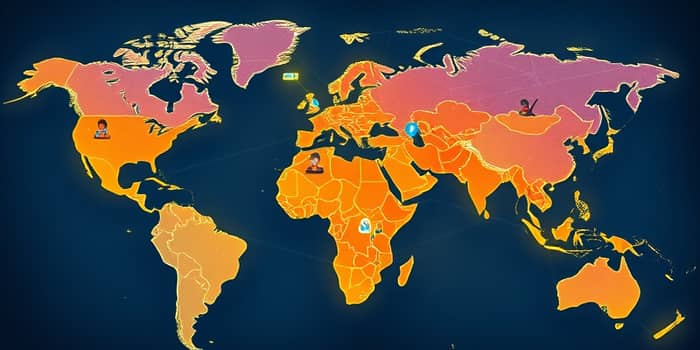
As millions of workers around the world send financial lifelines back home, global remittance flows have surged to unprecedented levels. In 2023, remittances reached approximately $883 billion, a testament to the resilience and solidarity of families separated by borders. By 2025, analysts forecast this figure will climb to $913 billion, and by 2029, it could exceed $1.067 trillion. This remarkable growth underscores the vital role remittances play in supporting communities, fostering economic stability, and fueling development.
Over the past decade, remittance flows have witnessed a steady climb, punctuated by a dramatic surge during the COVID-19 pandemic, when annual growth surpassed 10% between 2020 and 2021. Recent data indicate a compound annual growth rate (CAGR) of 6.4%, with market size expanding from $782.54 billion in 2024 to $832.57 billion in 2025. At this pace, the market is poised to reach $1.067 trillion by 2029, highlighting the enduring influence of cross-border transfers on the global financial landscape.
Despite economic headwinds, remittances remain a beacon of hope for many households. As economies recover unevenly, the steady inflow of funds from abroad cushions recipient nations against domestic downturns. The United States continues to be a major sending hub, while growing labor markets in Europe and the Gulf Cooperation Council further diversify the sources of these critical flows.
For many developing economies, remittances represent a cornerstone of national prosperity. In Tonga, remittance inflows account for nearly half of the country’s GDP, while in Lebanon they constitute 38%, and in Samoa 34%. Other nations—including Tajikistan, Gambia, Honduras, El Salvador, Haiti, and Nepal—depend on remittances for over one-fifth of their economic output. These funds not only sustain basic living expenses, but also finance education, healthcare, and small business ventures.
Beyond financial transactions, migrants send social remittances and knowledge transfer to their home regions, enriching local skills and fostering innovation. Cultural exchanges and entrepreneurial ideas travel alongside the funds, strengthening community ties and promoting sustainable development. In many cases, diaspora investments have led to improved infrastructure, better governance, and enhanced social cohesion.
The remittance ecosystem is undergoing a technological revolution. The adoption of fast, secure digital platforms has transformed how money moves across borders. Traditional money transfer operators now compete with fintech innovators offering mobile wallets and blockchain-based solutions. Initiatives like SWIFT gpi, Pix in Brazil, UPI in India, and the BIS Project Nexus are pioneering real-time payment rails, promising near-instant settlements and unparalleled transparency.
Consumer demand centers on transparent, low-cost remittance options. Recent surveys reveal that 65% of diaspora users prioritize speed, 44% are frustrated by unfavorable exchange rates, and 35% cite high or hidden fees as major concerns. To address these pain points, emerging technologies such as stablecoins and open banking platforms aim to achieve the G20’s target of 75% of cross-border remittance funds arriving within one hour by 2027.
Regulators worldwide are crafting frameworks that encourage innovation while safeguarding consumers. Sandbox initiatives allow fintech firms to pilot novel remittance solutions under regulatory oversight, while anti-money laundering and know-your-customer guidelines ensure integrity. Public-private collaborations are also advancing interoperability, enabling seamless currency conversion and settlement across disparate systems. These developments underscore the critical balance between fostering technological progress and upholding robust financial safeguards.
Navigating the complex world of remittances can be daunting. Whether you are sending money to family members or managing payroll for international employees, these actionable tips can help you maximize value and minimize costs.
By implementing these strategies, senders can stretch every dollar further, and recipients can enjoy more predictable financial support. Financial institutions and fintech firms alike are responding with user-friendly apps, intuitive interfaces, and robust customer service, making remittances more accessible than ever before.
The following table highlights the leading recipients of remitted funds in 2022, offering a snapshot of global dependency on these essential inflows.
Looking ahead, the remittance landscape is rife with opportunities for innovation. Financial inclusion initiatives are expanding access to unbanked populations, while regulatory reforms are streamlining cross-border payments. Fintech startups are exploring decentralized finance (DeFi) solutions, enabling peer-to-peer transfers without intermediaries. As digital currencies mature, we may witness a paradigm shift in how value is stored, transferred, and settled globally.
Meanwhile, businesses are gearing up for the rise of cross-border B2B transactions, projected to reach $120 trillion by 2025. Seamless international payment capabilities will be crucial for multinational supply chains, international freelancers, and digital nomads seeking flexible, borderless financial services. The convergence of traditional banking networks with fintech platforms promises a hybrid ecosystem that blends trust with agility.
Despite technological advances, the human element remains at the heart of remittance flows. Migrant workers exemplify perseverance, sending funds earned in distant lands to support loved ones back home. Their efforts drive global consumption, spur local enterprise, and forge transnational connections that transcend geography.
To harness the full potential of remittances, stakeholders must adopt a forward-thinking mindset. Governments can incentivize digital transfers through favorable policies and public-private partnerships. Financial institutions should prioritize stability during economic downturns by promoting diversified remittance channels. Meanwhile, migrant communities can benefit from financial literacy programs that impart actionable insights for financial resilience.
At an individual level, senders and recipients alike can cultivate savings habits, invest remitted funds in productive ventures, and leverage insurance products to safeguard against unforeseen shocks. By viewing remittances not merely as consumption support but as a catalyst for long-term growth, communities can transform temporary lifelines into sustainable development engines.
Global remittance flows are more than monetary transfers—they are manifestations of hope, solidarity, and collective aspiration. As remittances hit record highs, they reaffirm the power of diasporas to uplift families and fortify economies. By embracing new technologies, refining best practices, and fostering collaborative frameworks, we can ensure that these vital funds continue to flow efficiently, equitably, and securely.
Take the first step today: explore reputable platforms, compare your options, and connect with community resources to make your remittance experience smoother and more impactful.
References













